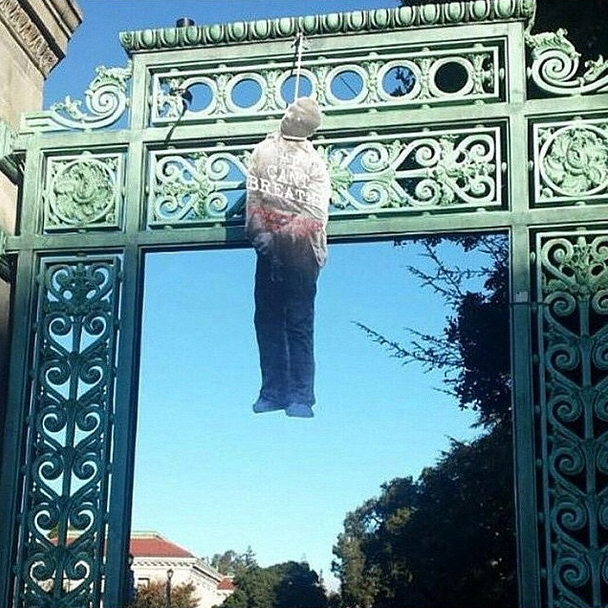/
The lynchings happened after the deputy sheriff and three others arrived at the Nelson home on May 2 to investigate the theft of a cow. L.D. Nelson shot and killed the deputy sheriff, and he and Laura Nelson, who had also touched the gun, were charged with murder.

“At around midnight on May 24, Laura and L.D. Nelson were both kidnapped from their cells by a group of between a dozen and 40 men,” according to Wikipedia.
“Sightseers gathered on the bridge the following morning and photographs of the hanging bodies were sold as postcards; the one of Laura is the only known surviving photograph of a female lynching victim. No one was ever charged with the murders; the district judge convened a grand jury, but the killers were never identified.”
Update, 1:10 p.m. Saturday: Rodolfo Mendoza-Denton, a UC Berkeley professor and national expert on intergroup relations — particularly related to race — said Saturday afternoon that he had been upset to learn about the effigies on campus earlier in the day.
“Whether it’s commentary or provocation, it’s atrocious,” he said. “It’s just mean, period. And heartless. And whoever did that simply needs to grow up.”
Mendoza-Denton said it’s difficult to know exactly how to interpret the effigies, whether as a “thoughtless joke” or “straight-up inflammatory racist behavior.”
“It falls somewhere along the line between prank and consciously racist messaging,” he said. “But it doesn’t matter. It’s absolutely thoughtless and wrong. Given the volatility of the situation, it’s just damaging to everybody. It’s a very public and clear example that racism exists at all levels of society, and it’s precisely the kind of symbol that protesters are protesting against.”
Mendoza-Denton said he has been keeping a close eye on this past week’s protests in Berkeley, and had been sad to see all the broken windows in businesses downtown as he drove through the area Saturday. He said he does not support the violence but, “at the same time, there’s a lot of pent-up frustration and anger.”
Mendoza-Denton said, beyond the protests, the community needs a forum to come together for healing and communication. A week and a half ago, the UC Berkeley Black Student Union held one such event on campus, and Berkeley High students along with REALM Charter School students staged a walkout and rally, which culminated with a “die-in” on the UC Berkeley campus several days ago.
Mendoza-Denton said there have been a number of informal forums, but that nothing large-scale has been planned by the university to his knowledge.
“We need to come together to heal,” he said. “There are a lot of different factions, a lot of different voices, and not a lot of control over the messaging one way or another. We need a forum to help us process these very emotionally laden, very relevant events. But that has to be a two-way street. It has to be a dialogue. And there’s got to be goodwill. And effigies are the very antithesis of that.”
Update, 12:26 p.m. Saturday: UC Berkeley spokeswoman Claire Holmes called Berkeleyside back to clarify some information.
She said University of California Police Department officers found two effigies hanging from Sather Gate on Saturday.
They also saw a photo of a third effigy in an area they think was the Campanile. When police went to remove it, they could not find it, said Holmes. Police believe that someone else took it down.
One of the effigies hanging from Sather Gate had “Can’t Breathe,” written on it. Eric Garner kept saying that when Staten Island police held him in a chokehold.
The effigies were life-size, she said They were cardboard cutouts, she said.
UC Berkeley Police received its first call about the matter at 9:10 a.m., she said.
Update 12:07 p.m. Saturday: UC police found three effigies hanging from a noose on the UC Berkeley campus this morning, according to Claire Holmes, a university spokeswoman. There was some writing on the effigies, including “Put Your Hands Up,” she said.
The effigies were found at Sather Gate and around the Campanile, she said. No suspects have been detained.
“It’s unclear what the intent was,,” said Holmes. “It could be that these are related to police violence and the protests that are going on in Ferguson. It could be racially motivated as well.”
Police are combing the campus to see if there are any others, said Holmes.

